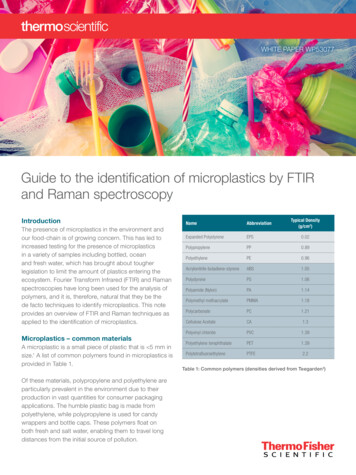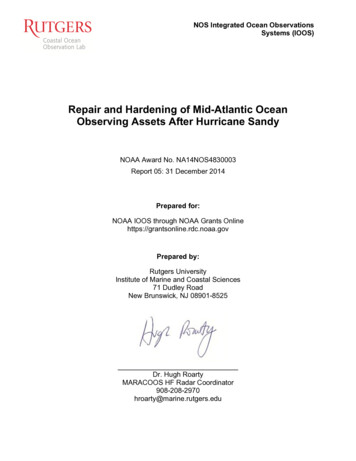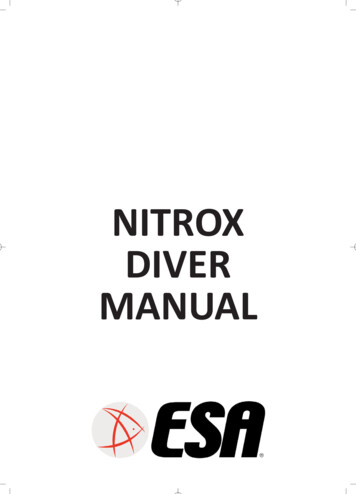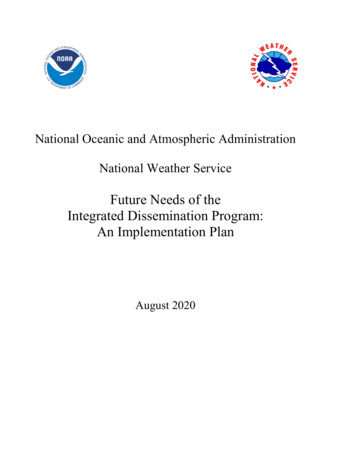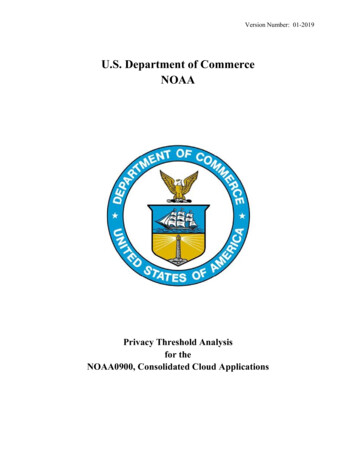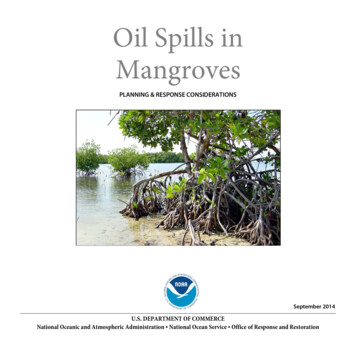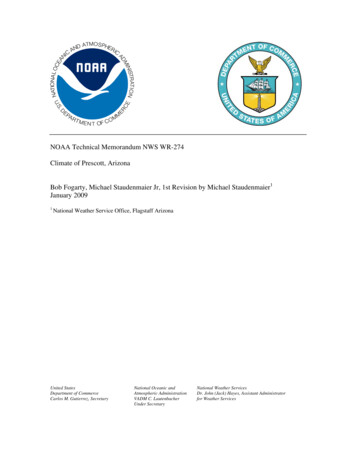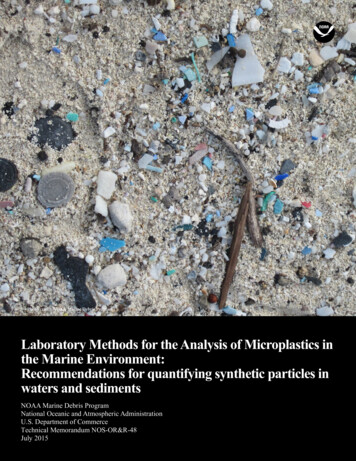
Transcription
Photo credit: NOAA Marine Debris ProgramLaboratory Methods for the Analysis of Microplastics inthe Marine Environment:Recommendations for quantifying synthetic particles inwaters and sedimentsNOAA Marine Debris ProgramNational Oceanic and Atmospheric AdministrationU.S. Department of CommerceTechnical Memorandum NOS-OR&R-48July 2015
Mention of trade names or commercial products does not constituteendorsement or recommendation for their use by the United Statesgovernment.
Laboratory Methods for theAnalysis of Microplastics inthe Marine EnvironmentRecommendations for quantifying synthetic particlesin waters and sedimentsJulie Masura1, Joel Baker1, Gregory Foster2, and Courtney Arthur3,4Carlie Herring, Technical Editor3,41Center for Urban Waters, University of Washington, Tacoma WADepartment of Chemistry and Biochemistry, George Mason University, Fairfax VA3I.M. Systems Group, Rockville MD4National Oceanic and Atmospheric Administration, Marine Debris Division, Silver Spring MD2The suggested citation for this document is:Masura, J., et al. 2015. Laboratory methods for the analysis of microplastics in themarine environment: recommendations for quantifying synthetic particles in watersand sediments. NOAA Technical Memorandum NOS-OR&R-48.For copies of this document, please contact:NOAA Marine Debris Division1305 East-West HighwaySilver Spring, MD 20910 USA
AcknowledgementsThe NOAA Marine Debris Program would like to acknowledge Sherry Lippiatt, Sarah OpferLowe, and Nir Barnea (NOAA National Ocean Service, Marine Debris Program) for reviewingthis manual and providing helpful comments and Asma Mahdi for design and layout. Fundingfor this project was provided by the NOAA Marine Debris Program.This publication does not constitute an endorsement of any commercial product or intend to bean opinion beyond scientific or other results obtained by the National Oceanic and AtmosphericAdministration. No reference shall be made to NOAA, or this publication furnished by NOAA,to any advertising or sales promotion which would indicate or imply that NOAA recommends orendorses any proprietary product mentioned herein, or which has as its purpose an interest tocause the advertised product to be used or purchased because of this publication. Althoughreleased by NOAA, the information in this paper does not reflect, represent, or form any part ofthe support of the policies of NOAA or the Department of Commerce.i Page
Laboratory Methods for the Analysis of MicroplasticsTable of ContentsAcknowledgements .iAbbreviations .iiiUnits.iiiMicroplastics Background . 1Introduction to Methods Manual . 21.0 Methods for the Analysis of Microplastics in Water Samples . 31.11.21.31.41.51.61.71.8Apparatus and Materials . 7Wet Sieving. 8Transfer Sieved Solids. 8Determine the Mass of Total Solids . 8Wet Peroxide Oxidation (WPO). 9Density Separation. 10Microscope Exam. 11Gravimetric Analysis .122.0 Methods for the Analysis of Microplastics in Beach Samples. 132.12.22.32.42.52.62.72.8Apparatus and Materials .15Beach Sediment Sample Preparation .16Density Separation.16Determine the Mass of Total Solids .17Wet Peroxide Oxidation (WPO).18Density Separation. 18Microscope Exam. 19Gravimetric Analysis .193.0 Methods for the Analysis of Microplastics in Bed Samples . 203.13.23.33.43.53.63.73.83.93.10Apparatus and Materials .22Bed Sediment Sample Preparation . 23Wet Sieving and Transfer of Sieved Solids .23Determine the Mass of Total Solids (Sample Matrix).23Density Separation.24Determine the Mass of Total Solids (Microplastics and Natural Materials) .24Wet Peroxide Oxidation (WPO).24Density Separation. 25Microscope Exam. 25Gravimetric Analysis .254.0 Cited References. 265.0 Appendices . 275.15.2Appendix of Calculations . 27Appendix of Guidelines and Considerations .29Note: All photos are credited to the University of Washington, Tacoma (with the exception ofthe cover photo to which the photo credit is the NOAA Marine Debris Program).ii P a g e
Laboratory Methods for the Analysis of MicroplasticsAbbreviations(aq)aqueousFe(II)iron (II)NaClsodium chloride (a salt)NOAANational Oceanic and Atmospheric AdministrationNOSNational Ocean ServiceOR&RNOAA Office of Response and RestorationPVCpolyvinylchlorideWPO*wet peroxide oxidation40Xmagnification with light microscopy by 40 milligrammLmillilitermmmillimeterminminute*The Wet Peroxide Oxidation (WPO) process results in a highly reactive mixture. Please reviewyour laboratory safety practices and policies before completing this analysis. In this manual, wehave highlighted the WPO steps with a CAUTION note.iii P a g e
Laboratory Methods for the Analysis of MicroplasticsMicroplastics BackgroundOver the past decade, microplastic debris in both marine and freshwater systems has become anemerging issue. There is an increased interest to understand the impacts of microplastics onaquatic wildlife, as the impacts still remain poorly understood (Thompson et al. 2004, Browne etal. 2007). Microplastics were first noted in North America as spherules in plankton tows alongthe coast of New England in the 1970s (Carpenter et al. 1972). Since then, microplastics havebeen found in most large bodies of water (oceans, seas, lakes, and rivers).Microplastics are plastic particles smaller than 5.0 mm in size (Arthur et al. 2009). The lowerbound (size) of the microplastics is not defined; however, it is common practice to use the meshsize (333µm or 0.33mm) of the neuston nets used to collect the samples (Arthur et al. 2009).There are two main ways microplastics are formed and enter a body of water: primary andsecondary microplastics (Arthur et al. 2009). Primary microplastics consist of manufactured rawplastic material, such as virgin plastic pellets, scrubbers, and microbeads (Browne et al. 2007,Arthur et al. 2009) that enter the ocean via runoff from land (Andrady 2011). Secondarymicroplastic introductions occur when larger plastic items (meso- and macro- plastics) enter abeach or ocean and undergo mechanical, photo (oxidative) and/ or biological degradation(Thompson et al. 2004, Browne et al. 2007, Cooper and Corcoran 2010, Andrady 2011). Thisdegradation breaks the larger pieces into progressively smaller plastic fragments whicheventually become undetectable to the naked eye.There are many uses for microplastics. For example, microbeads are used in personal careproducts such as exfoliants in face scrubs. Microplastics are also used to deliver drugs in somemedical applications (Browne et al. 2007). Further, fibers that shed from synthetic clothing andrope are microplastics (Thompson et al. 2004, Browne et al. 2007), as are particles used in“media blasting” processes to clean boat hulls and large machinery (Browne et al. 2007). Manyof these microplastics, microbeads, and fibers are small enough to pass through wastewatertreatment plants and enter a watershed (Browne et al. 2007).Impacts of microplastics on wildlife are not well understood at this time. However, a number oforganisms, both vertebrates and invertebrates have been found to ingest microplastics. Theseexamples represent numerous organisms with differing feeding mechanisms, includingdetritivores, deposit feeders, and filter feeders. Examples include scleractinian corals (Hall et al.2015), mussels (Mytilus edulis; Browne et al. 2007), fish (Carpenter et al. 1972), as well aslugworms, amphipods, and barnacles (Thompson et al. 2004).Scientists are also concerned that organisms ingesting plastic debris may be exposed tocontaminants sorbed to the plastic (Teuten et al. 2007). Plastic debris provides a sink and asource for chemical contaminants. Additives used in the manufacturing of plastics can leachfrom the plastics into the marine environment (Andrady 2011). On the other hand, hydrophobiccontaminants present in the water may sorb to the plastic particles (Carpenter et al. 1972, Teutenet al. 2007, Andrady 2011). Thus, microplastics may provide a mechanism to transportconcentrated contaminants to organisms (Browne et al. 2007).1 Page
Laboratory Methods for the Analysis of MicroplasticsIntroduction to Methods ManualThis document is a methods manual for measuring microplastic in the environment. This manualoutlines step-by-step instructions for quantifying microplastic in marine environmental samples,including processes to streamline terminology and approaches.The methods described here were determined after careful study and laboratory work conductedthrough a grant from the NOAA Marine Debris Program to the University of Washington,Tacoma. Project goals sought to streamline the terminology and techniques used to assessmicroplastic concentrations in marine environmental samples, and to develop laboratoryprocedures to quantify microplastic particles in marine surface waters and bed sediments, as wellas personal care products. An overarching aim was to provide scientists and educators withsimple techniques that are reproducible and robust without requiring extensive equipment, and todescribe a method that could be easily adopted by groups around the world.Depending on the study aims and environmental collection techniques, these techniques can beused to calculate concentrations of microplastics using a variety of metrics, including per piece,per mass, or per volume. Considering metrics is important for comparing results with otherresearchers. For guidelines and considerations when conducting microplastic analyses, as well ascalculations, see the appendices.2 Page
Laboratory Methods for the Analysis of Microplastics1.0 Methods for the Analysis ofMicroplastics in Water SamplesThis method can be used for the analysis of plastic debris as suspended solids in water samplescollected by a surface net. Plastics include hard plastics, soft plastics (e.g. foams), films, line,fibers, and sheets. The method involves the filtration of solids obtained in a 0.335 mm surfacesampling net (e.g. a manta net for surface water tows) through 5.6-mm and/or 0.3-mm sieves toisolate the solid material of the appropriate size (Figures 1-4). The sieved material is dried todetermine the solids mass in the sample. The solids are subjected to wet peroxide oxidation(WPO) in the presence of a Fe(II) catalyst to digest labile organic matter. The plastic debrisremains unaltered. The WPO mixture is subjected to density separation in NaCl(aq) to isolate theplastic debris through flotation. The floating solids are separated from the denser undigestedmineral components using a density separator. The floating plastic debris is collected in thedensity separator using a custom 0.3-mm filter, air-dried, and plastic material is removed andweighed to determine the microplastics concentration.Figure 1. Researchers use a manta net to collect surface water samples in the Thea FossWaterway, Puget Sound, Washington.3 Page
Laboratory Methods for the Analysis of MicroplasticsFigure 2. A water sample from Puget Sound is shown before processing.Figure 3. Note the variety in these field samples, all collected from surface waters.4 Page
Laboratory Methods for the Analysis of MicroplasticsFigure 4. Sieving and rinsing field samples.An overview of the analysis of microplastics in water is shown in Figure5.This method is applicable for the determination of many common plastics including polyethylene(0.91-0.97 g/mL), polypropylene (0.94 g/mL), polyvinyl chloride (1.4 g/mL), and polystyrene(1.05 g/mL).The plastic debris analyzed by this method is considered microplastic and ranges in size from 5mm to 0.3 mm. Microplastic debris is operationally defined by this method as any solid materialin the appropriate size range that is resistant to wet peroxide oxidation, exhibits flotation in a 5 MNaCl (d 1.15 g/mL) or 5.4 M lithium metatungstate (d 1.62 g/mL) solution, and passespositive visual inspection under a microscope at 40X power.5 Page
Laboratory Methods for the Analysis of MicroplasticsWater sample(1)Wet sieve(1.2) 0.3 mmfraction 5 mmfractionMass of totalsolids(1.3-1.4)WPO(1.5)Discard orArchiveDensity separation(1.6)Microscope exam(1.7)GravimetricAnalysis(1.8)Figure 5. Flow diagram for the analysis of microplastics in water samples. Note numbers referto the numbers in this section.6 Page
Laboratory Methods for the Analysis of Microplastics1.1Apparatus and Materials Stainless steel sieves, each measuring 8 in (diameter) and 2 in (depth)o 5.6 mm mesh (Number 3.5)o 1 mm mesh (Number 18)o 0.3 mm mesh (Number 50)Squirt bottle containing distilled water500-mL glass beakerAnalytical balance (precise to 0.1 mg)Metal spatulaDrying oven (90oC)Iron (Fe(II)) solution (0.05 M)o Prepared by adding 7.5 g of FeSO 4 7H 2 0 ( 278.02 g/mol) to 500 mL of waterand 3 mL of concentrated sulfuric acid30% Hydrogen peroxideStir barLaboratory hot plateWatchglassSodium chloride (commercial table salt is sufficient)Standard Metal ForcepsDensity separator, which is assembled using the following method:o A glass funnel (122-mm in diameter) is fitted with a 50-mm segment of latextubing on the bottom of the stem and a pinch clamp is attached to control liquidflow from the funnel.Retort standO-ringSpring clamp (2-inch)Aluminum foilCustomized small sieves, each measuring 59 mm (diameter), which may be fabricatedusing either of two methods:o Use polypropylene Büchner funnels and nylon mesh. The funnel bottoms areremoved and nylon mesh is glued to the modified funnel. Three funnels, withvarying nylon mesh size (5 mm, 1 mm, and 0.3 mm), are needed.o Cut sections of polyvinylchloride (PVC) pipe, approximately 75 mm (diameter)and 25 mm (length), and use gel-type superglue to attach nylon mesh to one endof the pipe. Three funnels, with varying nylon mesh size (5 mm, 1 mm, and 0.3mm), are needed.4-mL glass vialsDissecting microscope (40X magnification)7 Page
Laboratory Methods for the Analysis of Microplastics1.2Wet Sieving 1.3Pour the sample through a stacked arrangement of 5.6-mm (No. 3.5) and 0.3-mm (No.50) stainless steel mesh sieves (Figure 4).Rinse sample with squirt bottle filled with distilled water to transfer all residual solids tothe sieves. This also removes salts from the field sample. Repeat as necessary.Rinse sieves thoroughly using distilled water. Ensure all material has been well washed,drained, and sorted.Discard or archive material retained on 5-mm sieve, as appropriate, depending onindividual study objectives.Transfer Sieved Solids Weigh a clean and dry 500-mL beaker to the nearest 0.1 mg. (a)Transfer solids collected in the 0.3-mm sieve into the tared beaker using a spatula andminimal rinsing with a squirt bottle containing distilled water.Ensure all solids are transferred into the beaker.Place beaker in 90oC drying oven for 24 hours or longer to sample dryness (Figure 6).Figure 6. Sieved samples are dried in an oven to determine dry weight.1.4Determine the Mass of Total Solids Determine the mass of the beaker with dried solids using an analytical balance to thenearest 0.1 mg. (b)Subtract the mass of the tared beaker (a) to provide the mass of total solids (c) collectedon the sieve. (Formula: b – a c)* See Appendix 5.1.1 for formulae. This is the mass ofall microplastics and natural materials.8 Page
Laboratory Methods for the Analysis of Microplastics1.5Wet Peroxide Oxidation (WPO)CAUTION: This mixture is highly reactive. Please review and follow your laboratory safetypractices and policies for handling this mixture before completing this analysis. Add 20 mL of aqueous 0.05 M Fe(II) solution to the beaker containing the 0.3 mm sizefraction of collected solids (Figure 7).Figure 7. Addition of iron sulfate solution catalyzes the reaction. Add 20 mL of 30% hydrogen peroxide. CAUTION: this solution can boil violently ifheated 75oC (Figure 8).Figure 8. Addition of hydrogen peroxide oxidizes natural organic material. Let mixture stand on lab bench at room temperature for five minutes prior to proceedingto the next step.Add a stir bar to the beaker and cover with a watchglass.Heat to 75oC on a hotplate.9 Page
Laboratory Methods for the Analysis of Microplastics 1.6As soon as gas bubbles are observed at the surface, remove the beaker from the hotplateand place it in the fume hood until boiling subsides. If reaction appears to have thepotential to overflow the beaker, add distilled water to slow the reaction.Heat to 75oC for an additional 30 minutes.If natural organic material is visible, add another 20 mL of 30% hydrogen peroxide.Repeat until no natural organic material is visible.Add 6 g of salt (NaCl) per 20 mL of sample to increase the density of the aqueoussolution ( 5 M NaCl).Heat mixture to 75oC until the salt dissolves.Density Separation Transfer the WPO solution from step 1.5 to the density separator (Figure 9).Figure 9. A sample is depicted in a glass funnel to separate plastic. Rinse the WPO beaker with distilled water to transfer all remaining solids to the densityseparator.Cover loosely with aluminum foil.Allow solids to settle overnight.Visually inspect settled solids for any microplastics. If any are present, drain the settledsolids from the separator and remove microplastics using forceps. Archive or discard.Drain settled solids from the separator and discard.Collect floating solids in a clean 0.3-mm custom sieve (Figure 10).10 P a g e
Laboratory Methods for the Analysis of MicroplasticsFigure 10. Floating material is drained into a custom sieve. Rinse the density separator several times with distilled water to transfer all solids to the0.3-mm sieve.Allow the sieve to air dry while loosely covered with aluminum foil for 24 hours (Figure11).Figure 11. A prepared sample is ready for microscope examination.1.7Microscope Exam Weigh a clean and dry 4-mL vial. Include the label and cap. (d)Under a dissecting microscope at 40X magnification (Figure 12), use forceps to collectidentifiable microplastics from the 0.3-mm sieve and transfer them to the tared vial(Figure 13). See Appendix 5.2 for more guidance.11 P a g e
Laboratory Methods for the Analysis of MicroplasticsFigure 12. Microplastic fragments are extracted from the prepared sample during a microscopeexamination.Figure 13. A final microplastic sample is preserved in a vial.1.8Gravimetric Analysis Weigh the mass of the vial and microplastics to the nearest 0.1 mg. (e)Subtract the mass of the tared vial (d) to provide the mass of microplastics (f) collectedon the sieve. (Formula: e-d f)* See Appendix 5.1.1 for formulae. This is the mass of allmicroplastics.12 P a g e
Laboratory Methods for the Analysis of Microplastics2.0 Methods for the Analysis ofMicroplastics in Beach SamplesThis method can be used for the analysis of plastic debris in beach sand collected by shovel orspade. Plastics include hard plastics, soft plastics (e.g., foams), films, line, fibers, and sheets. Themethod involves sieving dry beach samples to 5 mm to remove large macroscopic debris.An overview of the analysis of microplastics in beach sand is shown inFigure 14.This method is applicable for the determination of many common plastics including polyethylene(0.91-0.97 g/mL), polypropylene (0.94 g/mL), polyvinyl chloride (1.4 g/mL), and polystyrene(1.05 g/mL).The plastic debris analyzed by this method is considered microplastic and ranges in size from 5mm to 0.3 mm. Microplastic debris is operationally defined by this method as any solid materialin the appropriate size range that is resistant to wet peroxide oxidation, exhibits flotation in a 5 MNaCl (d 1.15 g/mL) or 5.4 M lithium metatungstate (d 1.62 g/mL) solution, and passespositive visual inspection under a microscope at 40X power.13 P a g e
Laboratory Methods for the Analysis of MicroplasticsBeach sample(2)Samplepreparation(2.2)Density separation(2.3)Floating solidsSettled solidsMass of totalsolids(2.4)DiscardWPO(2.5)Density separation(2.6)Microscope exam(2.7)GravimetricAnalysis(2.8)Figure 14. Flow diagram for the analysis of microplastics in beach samples. Note numbers referto the numbers in this section.14 P a g e
Laboratory Methods for the Analysis of Microplastics2.1Apparatus and Materials 800-mL and 500-mL glass beakersAnalytical balance (precise to 0.1 mg)Drying oven (90oC)Lithium metatungstate solutiono Prepared from commercial lithium metatungstate solution ( 2.95 g/mL) anddiluted as needed with deionized water to 1.6 g/mLMetal spatulaCustomized small sieves, each measuring 59 mm (diameter), which may be fabricatedusing either of two methods:o Use polypropylene Büchner funnels and nylon mesh. The funnel bottoms areremoved and nylon mesh is glued to the modified funnel. Three funnels, withvarying nylon mesh size (5 mm, 1 mm, and 0.3 mm), are needed.o Cut sections of polyvinylchloride (PVC) pipe, approximately 75 mm (diameter)and 25 mm (length), and use gel-type superglue to attach nylon mesh to one endof the pipe. Three funnels, with varying nylon mesh size (5 mm, 1 mm, and 0.3mm), are needed.Standard Metal ForcepsIron (Fe(II)) solution (0.05 M)o Prepared by adding 7.5 g of FeSO 4 7H 2 0 ( 278.02 g/mol) to 500 mL of waterand 3 mL of concentrated sulfuric acid30% Hydrogen peroxideStir barWatchglassLaboratory hot plateSquirt bottle containing distilled waterSodium chloride (commercial table salt is sufficient)Density separator, which is assembled using the following method:o A glass funnel (122-mm in diameter) is fitted with a 50-mm segment of latextubing on the bottom of the stem and a pinch clamp is attached to control liquidflow from the funnel.Retort standO-ringSpring clamp (2-inch)Aluminum foil4-mL glass vialsDissecting microscope (40X magnification)15 P a g e
Laboratory Methods for the Analysis of Microplastics2.2Beach Sediment Sample Preparation Weigh and label a clean and dry 800-mL beaker to the nearest 0.1 mg. (a)Weigh 400 g of wet sediment to the nearest 0.1 mg and add to the beaker (Figure 15).Figure 15. A beach sand (or sediment) sample is weighed. 2.3Dry in a drying oven at 90 C overnight or until sample dryness.Weigh the dried beaker and material to determine the dry sample weight. (b)Subtract the mass of the tared beaker (a) to provide the mass of total solids (c). (Formula:b – a c)* See Appendix 5.1.2 for formulae. This is the mass of the sample matrix.Density Separation Add 300 mL of aqueous lithium metatungstate (d 1.6 g/mL) solution to the driedsediments in the 800-mL beaker (Figure 16). Be sure to adjust density to 1.6 g/mL. SeeSection 2.1 (Apparatus and Materials) for preparation instructions.Figure 16. Lithium metatungstate is added to a sediment sample.16 P a g e
Laboratory Methods for the Analysis of Microplastics Vigorously stir the sand-water mixture in the beaker for several minutes with a spatula tofloat out the microplastics.Transfer all floating solids in the beaker to the custom 0.3 mm sieve. Rinse beaker withdistilled water to transfer all residual solids to the sieves.Remove any visible material 5 mm with forceps. Either discard or archive, dependingon individual study objectives.Discard or archive settled solids left in the beaker.Weigh and label a clean and dry 500-mL beaker to the nearest 0.1 mg. (a)Transfer the solids collected on the 0.3-mm sieve into the tared 500-mL beaker.Repeat until all of the floating debris is collected.Dry the beaker and solids in a drying oven at 90oC for 24 hours or longer to sampledryness (Figure 6).Recover and filter the metatungstate solution in a separate bottle to recycle for future use(Figure 17).Figure 17. The lithium metatungstate solution is sieved and saved.2.4Determine the Mass of Total Solids Determine the mass of the beaker with dried solids using an analytical balance to thenearest 0.1 mg. (b)Subtract the mass of the tared beaker (a) to provide the mass of total solids (c). (Formula:b – a c)* See Appendix 5.1.2 for formulae. This is the mass of all microplastics andnatural materials.17 P a g e
Laboratory Methods for the Analysis of Microplastics2.5Wet Peroxide Oxidation (WPO)CAUTION: This mixture is highly reactive. Please review and follow your laboratory safetypractices and policies for handling this mixture before completing this analysis. 2.6Add 20 mL of aqueous 0.05 M Fe(II) solution to the beaker containing the 0.3 mm sizefraction of collected solids (Figure 7).Add 20 mL of 30% hydrogen peroxide. CAUTION: this solution can boil violently ifheated 75oC (Figure 8).Let mixture stand on lab bench at room temperature for five minutes prior to proceedingto the next step.Add a stir bar to the beaker and cover with a watchglass.Heat to 75oC on a hotplate.As soon as gas bubbles are observed at the surface, remove the beaker from the hotplateand place it in the fume hood until boiling subsides. If the reaction appears to have thepotential to overflow the beaker, add distilled water to slow the reaction.Heat to 75oC for an additional 30 minutes.If natural organic material is visible, add another 20 mL of 30% hydrogen peroxide.Repeat until no natural organic material is visible.Add 6 g of salt (NaCl) per 20 mL of sample to increase the density of the aqueoussolution ( 5 M NaCl).Heat mixture to 75oC until the salt dissolves.Density Separation Transfer the WPO solution from step 2.5 to the density separator (Figure 9).Rinse the WPO beaker with distilled water to transfer all remaining solids to the densityseparator.Cover loosely with aluminum foil.Allow solids to settle overnight.Visually inspect settled solids for any microplastics. If any are present, drain the settledsolids from the separator and remove m
The NOAA Marine Debris Program would like to acknowledge Sherry Lippiatt, Sarah Opfer Lowe, and Nir Barnea (NOAA National Ocean Service, Marine Debris Program) for reviewing this manual and providing helpful comments and Asma Mahdi for design and layout. Funding for this project was pro
